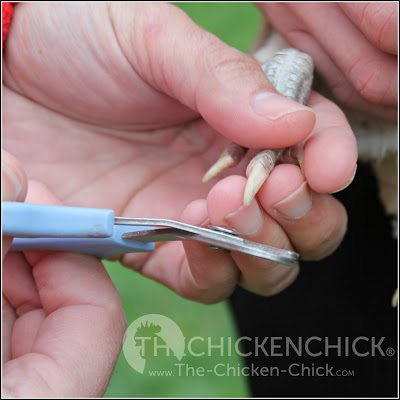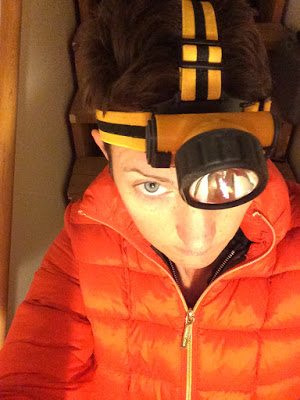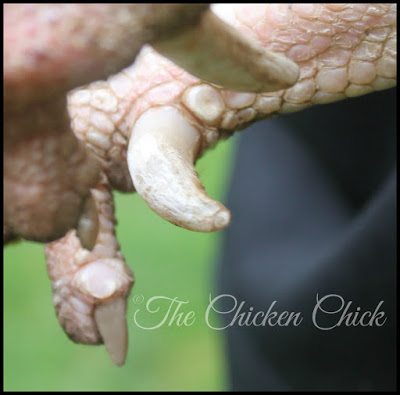Some breeds, including Silkies, have extra toes that grow in funky directions, requiring periodic nail clipping.
Equipment Needed:
- Styptic powder and paper towels on standby
- Dog nail clippers (guillotine style or plier-style clippers with a safety guard)
- OR a Dremmel tool (the noise and vibration are upsetting to many chickens, so I opt for nail clippers)
- Nail file or Nail Grinder tool (optional)
- Vetericyn Plus Poultry Wound Care spray: http://amzn.to/2jhxZDT
- A partner to hold the chicken.
A chicken’s nails contain a vein that will bleed if the nail is cut too far towards the toe, so keep styptic powder at the ready while trimming. In good light, the vein can usually be seen under the nail of chickens with light colored nails. Always trim conservatively to avoid nicking the vein.
Most chickens don’t care to be handled, so it is easiest to trim a chicken’s nails or spurs well after dark when they’re roosting and half asleep using a headlamp and a partner.
With a partner holding the chicken securely, hold the foot firmly in one hand, isolating the toenail to be trimmed and the nail clippers in the other. Trim 1/4-1/3 of the length of the nail. If the vein is nicked and bleeds, immediately dip the nail in styptic powder and hold gentle pressure on it with a paper towel until bleeding stops. File any sharp or jagged edges.
TRIMMING A ROOSTER’S SPURS
Spurs are horn-like, bony projections that grow out of the back of a rooster’s lower leg that are used for personal defense and flock protection. Think of the spur like a thumb that’s completely covered by a thick, sharp fingernail. A rooster’s spurs continue to grow just as his nails do and if left unchecked, can interfere with his ability to walk, cause injuries to him and others. To maintain a reasonable spur length, the spur cap can be removed or trimmed, however, when the hard outer layer of the spur is removed, the exposed bony tissue may bleed, is very sensitive, if not painful when touched, and is vulnerable to infection. For these reasons, I do not uncap my roosters’ spurs, preferring to trim them instead. The same method for trimming nails applies to spurs: steer clear of the live tissue underneath the spur cap, cutting only the first 1/4-1/3 of the projection with very sharp, large dog clippers, filing to dull any sharp edges. The spur caps will re-grow.
Kathy Shea Mormino
Affectionately known internationally as The Chicken Chick®, Kathy Shea Mormino shares a fun-loving, informative style to raising backyard chickens. …Read on


shop my SPONSORS







































Sure would be nice for my new chicks coming next week!
Would love to win a brooder.
You always have such great giveaways!!! Not sure how you do it but love entering for a chance to win the items I dream about owning! I recently got 3 creasted cream legbars, one being a rooster. I take care of my 2 year old granddaughter while our daughter works and she just loves the chickens and other farm animals they we own. I didn’t want to ruin that so I got an enclosed coop and run to keep my breeding chicks in while she is at our house. They will free range with the others when she is not… Read more »
Great article! Super excited about this brooder giveaway! Just completed my first hatch with my brand new incubator and this would be perfect for future stress. I always worry about heat lamps with chicks. ?
Would love to win this for my brooder.